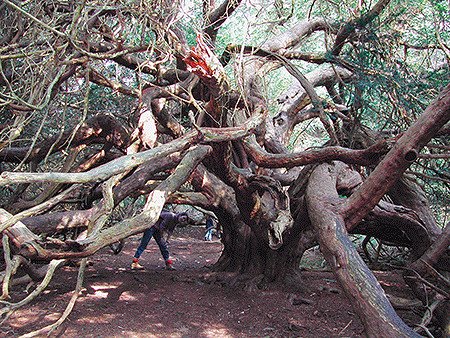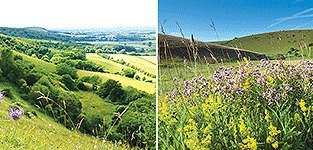Sussex Wildlife Trust: Yew Tree
February 1st, 2021 The trees were planted as a symbol of everlasting life and a reminder of the Easter resurrection.
The trees were planted as a symbol of everlasting life and a reminder of the Easter resurrection.Palm Sunday commemorates Jesus’ famed donkey ride into Jerusalem. Recreating that palm-branch-strewn journey in Britain has been botanically challenging, since palm trees don’t grow in our climate. Instead, churches gathered sprigs of native yew to provide the ceremonial décor and in some areas, the Sunday before Easter became known as Yew Sunday. And that’s why every churchyard has a yew.
Well, actually the yew’s churchyard connection is because yews are evergreen and can miraculously regrow from a dead stump. The trees were planted as a symbol of everlasting life and a reminder of the Easter resurrection.
But, hold up; how come over 500 churchyard yews in England and Wales are older than their churches? It must mean that the yews themselves were pagan places of worship and the churches were built around them. Or they were planted on the graves of plague victims to purify the dead. Or it could be something to do with long bows. Or keeping the waiting congregation sheltered and dry each Sunday.
No-one seems sure where this association started but, whatever the reason, yews look right at home in churchyards. Dark, dense and unmoving they solemnly preside over the sad ceremonies held underneath their boughs and have seen generations come and go (but mostly go).
Yews themselves deliver death and every part of them is highly poisonous; their leaves, their bark, their seeds. Only the fleshy red arils around the toxic seeds are harmless, encouraging birds to feed on them and disperse the poisonous cargo within. Yet death itself does not seem to inconvenience the yew.
Two rival British yews are advertised as the oldest living thing in Europe, at an alleged 5000 years old. Not many yews in Sussex can rival these great evergreen granddaddies.
Most of our whippersnappers are probably just a couple of hundred years old. The problem is it’s hard to accurately age a yew.
As they get older, their blood red heart-wood rots, leaving them hollow inside and without traditional growth rings. Its heart may no longer be in it but that won’t stop the yew from growing.
One of the oldest yews in Sussex can be found in Stedham churchyard near Midhurst. It’s estimated to be a mind-boggling 2,500 years old. Over in Wilmington, at the foot of the Long Man, a monstrous yew dominates the churchyard. At a reputed age of 1600 the tree is 600 years older than the church.
Supported by wooden props and straining against rusting chains, it’s as if a travelling circus is exhibiting an aging dinosaur.
It’s worth a visit to both these old timers. For me, standing in the shadow of a plant that is 40 times older than you is humbling and a reminder that for us mere humans, life is brief.
By Michael Blencowe: Learning & Engagement Officer, Sussex Wildlife Trust
Sussex Wildlife Trust is an independent registered charity caring for wildlife and habitats throughout Sussex. Founded in 1961, we rely on the support of our members to help protect our rich natural heritage. Please consider supporting our work. As a member you will be invited to join Michael Blencowe on our regular wildlife walks and also enjoy free events, discounts on wildlife courses, Wildlife magazine and our guide book: Discovering Wildlife in Sussex.
It’s easy to join online at: www.sussexwildlifetrust.org.uk/join or T: 01273 497532.
Ancient yew©Sussex Wildlife Trust.
Well, actually the yew’s churchyard connection is because yews are evergreen and can miraculously regrow from a dead stump. The trees were planted as a symbol of everlasting life and a reminder of the Easter resurrection.
But, hold up; how come over 500 churchyard yews in England and Wales are older than their churches? It must mean that the yews themselves were pagan places of worship and the churches were built around them. Or they were planted on the graves of plague victims to purify the dead. Or it could be something to do with long bows. Or keeping the waiting congregation sheltered and dry each Sunday.
No-one seems sure where this association started but, whatever the reason, yews look right at home in churchyards. Dark, dense and unmoving they solemnly preside over the sad ceremonies held underneath their boughs and have seen generations come and go (but mostly go).
Yews themselves deliver death and every part of them is highly poisonous; their leaves, their bark, their seeds. Only the fleshy red arils around the toxic seeds are harmless, encouraging birds to feed on them and disperse the poisonous cargo within. Yet death itself does not seem to inconvenience the yew.
Two rival British yews are advertised as the oldest living thing in Europe, at an alleged 5000 years old. Not many yews in Sussex can rival these great evergreen granddaddies.
Most of our whippersnappers are probably just a couple of hundred years old. The problem is it’s hard to accurately age a yew.
As they get older, their blood red heart-wood rots, leaving them hollow inside and without traditional growth rings. Its heart may no longer be in it but that won’t stop the yew from growing.
One of the oldest yews in Sussex can be found in Stedham churchyard near Midhurst. It’s estimated to be a mind-boggling 2,500 years old. Over in Wilmington, at the foot of the Long Man, a monstrous yew dominates the churchyard. At a reputed age of 1600 the tree is 600 years older than the church.
Supported by wooden props and straining against rusting chains, it’s as if a travelling circus is exhibiting an aging dinosaur.
It’s worth a visit to both these old timers. For me, standing in the shadow of a plant that is 40 times older than you is humbling and a reminder that for us mere humans, life is brief.
By Michael Blencowe: Learning & Engagement Officer, Sussex Wildlife Trust
Sussex Wildlife Trust is an independent registered charity caring for wildlife and habitats throughout Sussex. Founded in 1961, we rely on the support of our members to help protect our rich natural heritage. Please consider supporting our work. As a member you will be invited to join Michael Blencowe on our regular wildlife walks and also enjoy free events, discounts on wildlife courses, Wildlife magazine and our guide book: Discovering Wildlife in Sussex.
It’s easy to join online at: www.sussexwildlifetrust.org.uk/join or T: 01273 497532.
Ancient yew©Sussex Wildlife Trust.
Comments (0)
No comments have been submitted yet.Why not be the first to send us your thoughts
Leave A Comment
Thank you for your comments, they will appear shortly once approved.
Recent Posts
Have You Seen...






